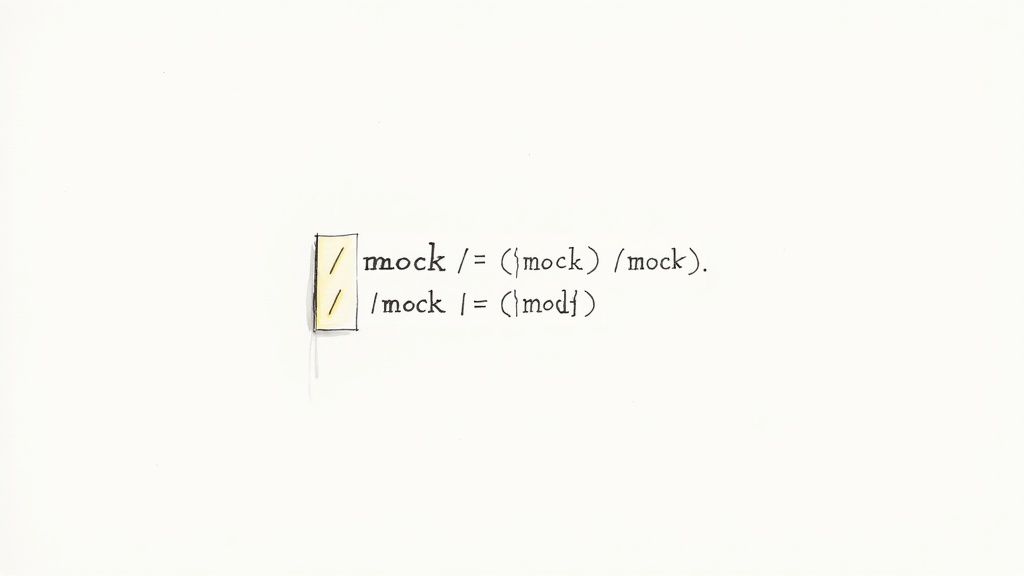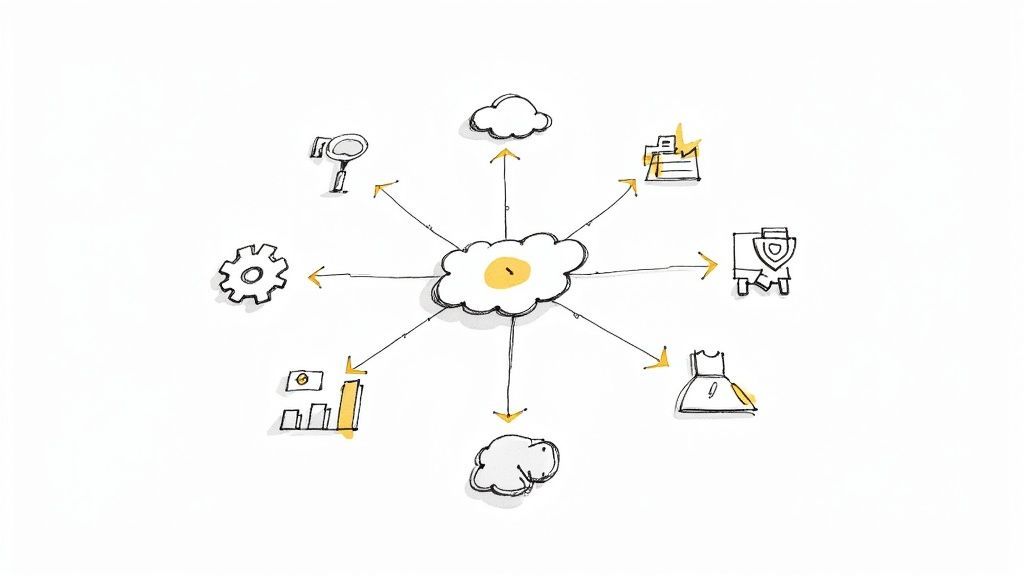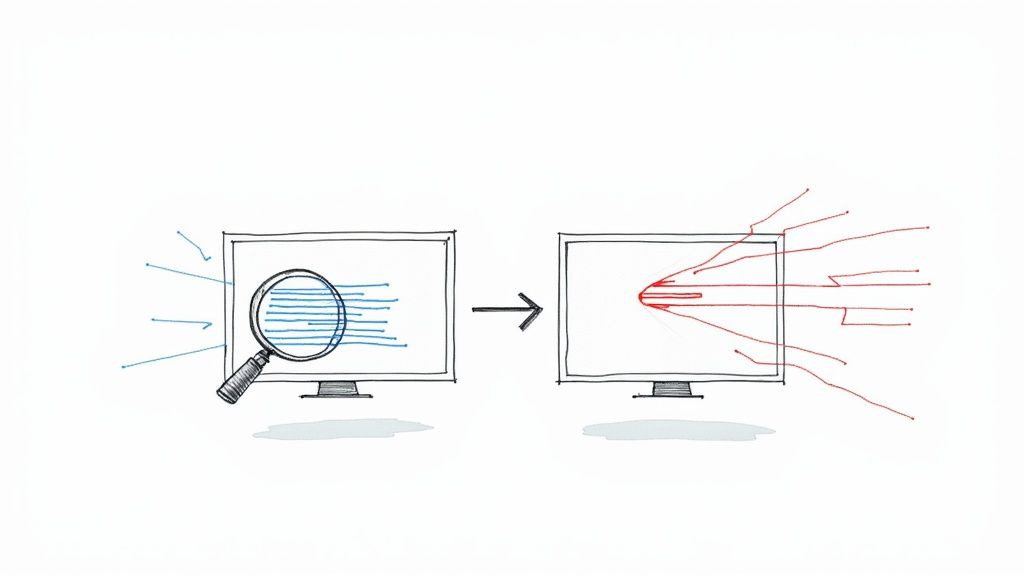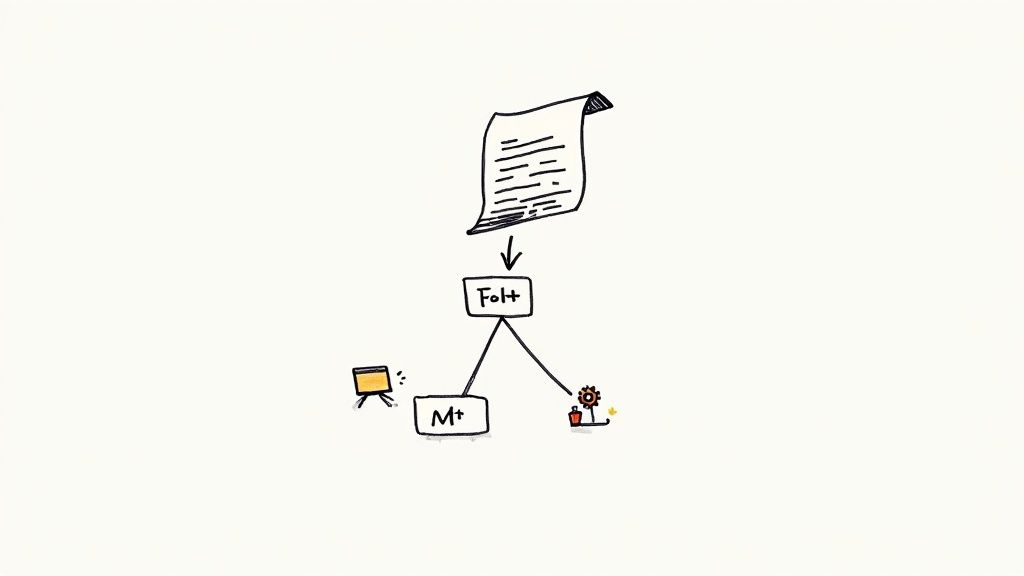Master pytest-mock: Elevate Python Testing

The Power of Pytest-Mock: Why Developers Are Switching

Modern software development requires thorough testing. For Python developers, the pytest framework combined with the pytest-mock plugin has become a popular choice. This powerful plugin integrates seamlessly with pytest, providing a streamlined way to handle mocking. Mocking allows developers to isolate parts of their code, leading to predictable test results and simplified testing of complex interactions.
Imagine needing to test a function that interacts with a database. Directly connecting to a database during testing can be slow and unreliable. pytest-mock lets you simulate that database interaction, keeping tests fast, reliable, and independent.
Why the Switch? Improved Mocking
pytest-mock enhances Python's built-in unittest.mock library. While unittest.mock provides the core mocking tools, pytest-mock simplifies its use within pytest. Its intuitive mocker fixture makes creating and managing mocks more straightforward and declarative. This cleaner approach promotes readable tests, which makes collaboration and maintenance easier for teams. Instead of becoming a burden, tests become living documentation.
Pytest-Mock’s Growing Popularity
As Python projects become more complex, tools like pytest-mock become essential. It builds on top of the unittest framework, simplifying mocking and improving the readability of tests. Pytest is used by over 40% of Python developers as of 2024, significantly impacting how tests are written and mocks are implemented. You can explore this topic further here.
pytest-mock’s declarative style allows developers to specify expected calls and behaviors directly within tests. This results in cleaner, more maintainable code, contributing to the plugin's widespread adoption. But the advantages go beyond simple convenience.
Benefits of Using Pytest-Mock
- Improved Test Readability:
pytest-mock's syntax makes test code easier to understand and maintain. - Simplified Mocking: The
mockerfixture provides a simple way to create and manage mocks. - Faster Test Execution: Mocking dependencies speeds up testing considerably.
- Increased Test Reliability: Isolating tests using mocks leads to more consistent and dependable results.
pytest-mock lets developers focus on what to mock instead of how to mock it. This simplification streamlines the testing process, making writing effective tests less demanding. Ultimately, pytest-mock helps developers create more reliable software through better testing.
From Zero to Hero: Your Pytest-Mock Onboarding Guide

Getting started with pytest-mock is surprisingly simple, even if you're new to testing. This guide offers a practical, step-by-step introduction to incorporating pytest-mock into your development workflow. We'll explore common installation and configuration practices used by development teams.
Installation and Setup
The first step is installing pytest-mock using pip:
pip install pytest-mock
This command adds the plugin to your environment, preparing you to harness the power of mocks in your tests.
Your First Mock Test
Let's address a common testing scenario: external API dependencies. Consider a function that retrieves data from an external API. Directly testing this function can be slow and unreliable. pytest-mock offers a more effective solution.
import requests
def get_cat_facts(): response = requests.get("https://catfact.ninja/fact") return response.json()['fact']
def test_get_cat_facts(mocker): mock_response = mocker.patch('requests.get') mock_response.return_value.json.return_value = {'fact': 'Cats sleep 70% of their lives.'} assert get_cat_facts() == 'Cats sleep 70% of their lives.'
In this example, the mocker fixture, provided by pytest-mock, patches the requests.get function. This means your test uses a mocked response instead of making a real API call, resulting in faster and more dependable tests.
Beyond the Basics: Databases and Files
The utility of pytest-mock extends beyond APIs. It's equally valuable for mocking database interactions and file system operations. Without mocking, these operations can slow down your test suite considerably.
If your code interacts with a database, for instance, you can mock the database connection to prevent actual queries during testing. You can similarly mock file read/write operations to isolate your tests and avoid creating unnecessary files. This ensures your tests run quickly and consistently, regardless of external factors.
Practical Comparisons: Before & After
The impact of pytest-mock is best demonstrated through practical comparisons. Imagine a test suite that takes several minutes to run because of numerous external dependencies. By mocking those dependencies, you can significantly reduce execution time. Some developers have reported reductions of up to 90% when implementing pytest-mock effectively. This increased speed translates directly into a more efficient development process.
Pytest-Mock Techniques That Solve Real Testing Problems

Mastering pytest-mock involves more than just the basics. This section dives into advanced strategies for handling the complex scenarios you'll find in real-world applications, from intricate object interactions to those tricky dependencies. These techniques will help you create tests that are both robust and easy to maintain.
Mocking Class Methods and Module Functions
Testing code that interacts with class methods or module functions can be simplified with pytest-mock. Imagine a class that works with a database. Instead of setting up a real database for testing, you can mock specific methods.
class DatabaseConnector: def connect(self): # ... database connection logic ...
def test_database_interaction(mocker): mock_connect = mocker.patch.object(DatabaseConnector, 'connect') connector = DatabaseConnector() connector.connect() mock_connect.assert_called_once()
This example shows how to patch the connect method using mocker.patch.object. This isolates the code you're testing without needing a live database connection. The same approach works for patching module-level functions, making your tests faster and more consistent.
Mocking Context Managers
Python's context managers, frequently used for resource management, can also be mocked with pytest-mock. This is particularly helpful when testing code that opens files or makes network connections. By mocking the context manager, you can test the code's behavior without actual file operations or network activity.
Testing Asynchronous Functions and Generators
Asynchronous programming and generators are key parts of modern Python. pytest-mock handles these elegantly. You can mock asynchronous functions with mocker.async_patch and test generators by mocking their individual yields. Combine these techniques with other Pytest features like pytest-asyncio for a truly comprehensive testing strategy.
Practical Examples From Real Codebases
Using these advanced techniques in real projects can significantly improve your testing. For example, when testing a web service, mocking dependencies like external APIs makes development and maintenance much simpler.
- Problem: Slow and unreliable tests because of external API dependencies.
- Solution: Use
pytest-mockto simulate API responses. This isolates the web service logic, giving you faster, more predictable tests.
For data processing systems, mocking complex object interactions reduces the need for real data during testing. This allows for more focused and controlled test scenarios.
- Problem: Complex object interactions make tests hard to manage.
- Solution:
pytest-mocklets you mock specific methods within objects, simplifying your test design and giving you more control over test behavior.
Let's look at a comparison of different mocking approaches in Python. The following table highlights key differences and similarities between pytest-mock and other options.
Comparing Mocking Approaches in Python
This table compares pytest-mock with other mocking libraries and approaches in the Python ecosystem.
| Mocking Solution | Syntax Complexity | Integration with Pytest | Learning Curve | Key Features |
|---|---|---|---|---|
pytest-mock |
Simple, integrates directly with pytest fixtures | Seamless | Easy | Fixture injection, async support |
unittest.mock |
Can be more verbose | Requires manual setup | Moderate | Built-in mocking library |
mock (for Python 2) |
Similar to unittest.mock |
Requires manual setup | Moderate | Backwards compatibility |
As you can see, pytest-mock shines with its simple syntax and seamless integration with Pytest. While other solutions offer similar functionality, the streamlined experience provided by pytest-mock often makes it the preferred choice for testing in Python.
These real-world examples show how powerful pytest-mock can be for simplifying tests, even in the most complex Python applications. By mastering these techniques, you can create tests that are robust, maintainable, and highly effective.
Accelerate Your Test Suite with Pytest-Mock Strategies

Slow tests can be a real drag on development. They interrupt your flow and make it harder to iterate quickly. That's where pytest-mock comes into play. By strategically mocking dependencies, you can significantly speed up your test suite. This creates tighter feedback loops and allows for more rapid development. This is especially useful when dealing with external services or time-consuming operations that add latency to your tests.
Identifying Mocking Candidates
The first step to faster tests is figuring out what's slowing them down. Look for external dependencies like database queries, network requests, and file system interactions. These are often the primary culprits and ideal candidates for mocking. For instance, if your tests involve numerous database queries, each taking several seconds, mocking them can save a substantial amount of time.
Measuring the Performance Impact
Once you've identified potential mocking candidates, it's important to quantify the potential improvements. Run your tests both with and without mocks to measure the actual time saved. This data will give you a clear picture of how mocking impacts your test suite's overall speed, helping justify the effort required to implement the mocks.
Implementing Targeted Mocks with Pytest-Mock
After measuring the potential gains, you can start mocking the identified dependencies using pytest-mock. The mocker fixture in pytest-mock simplifies replacing slow components with fast, predictable mock objects. This lets you maintain accurate tests while drastically reducing execution time.
The power of pytest-mock lies in its ability to dramatically cut down testing time. By simulating responses, like those from external APIs, you effectively eliminate wait times. Imagine testing a REST API; each test could take several milliseconds or even seconds. With pytest-mock, you can potentially reduce execution time by up to 90%, depending on the specific scenario. This faster testing makes development more efficient and ensures tests run consistently, regardless of network latency or other external factors. Learn more about mocking with pytest-mock here.
Balancing Test Coverage and Efficiency
While speed is important, maintaining good test coverage is equally crucial. Aim for a balance between mocking for efficiency and performing real interactions to validate real-world behavior. Over-mocking can lead to inaccurate test results, while under-mocking can make your tests unnecessarily slow. Consider mocking less critical interactions for speed, while keeping real interactions for vital components. This targeted approach ensures both fast and accurate tests.
Practical Metrics for Optimization
Use metrics to guide your mocking strategy. Track test execution times over time to spot any slowdowns. Set performance goals for your test suite to ensure you're meeting your speed objectives. This data-driven approach to optimization will help you keep your tests fast and efficient. Continuously monitoring performance and making adjustments as needed will help you maintain a quick and dependable testing process.
Pytest-Mock Patterns That Seasoned Developers Swear By
Testing is crucial for building reliable software. However, tests themselves can become complex and difficult to manage. Using pytest-mock effectively goes beyond the basics. This section explores proven patterns used by experienced developers to write cleaner, more maintainable tests. These patterns help ensure your tests are valuable validation tools, not just implementation mirrors.
Structuring Tests for Clarity
A well-structured test is easy to understand and modify. Senior developers often use the "Arrange, Act, Assert" pattern.
- Arrange: Set up the necessary preconditions, including mocking dependencies. This is where you use the
mockerfixture to prepare your mock objects. - Act: Execute the code you are testing. This might involve calling a function or method.
- Assert: Verify the outcome against your expected results. This confirms your code behaves correctly.
This separation simplifies debugging. If an assertion fails, you can quickly find the issue by examining the "Act" and "Arrange" sections.
Balancing Mocked and Real Components
Over-mocking creates tests that don't accurately reflect real-world behavior. Experienced developers balance by mocking external dependencies and complex interactions, leaving core logic untouched.
For example, when testing a function sending data to a remote server, mocking the network interaction is essential. But, mocking the internal data preparation logic is unnecessary unless it causes a significant performance bottleneck during testing. This focuses tests on critical aspects while keeping them fast and reliable.
Effective Mock Scoping
Incorrectly scoped mocks can cause confusion and unexpected test results. pytest-mock provides granular control. Using mocker.patch with the right target ensures mocks only affect the intended code. This prevents side effects and keeps tests focused.
- Target Specific Modules/Classes: Use
mocker.patch('module.function')ormocker.patch.object(Class, 'method')for precise targeting. - Use
withStatements for Local Scope: Restrict a mock's scope withwith mocker.patch(...):
with mocker.patch('os.path.exists'): # Mock only within this block # ... test code ...
Proper Verification and Monkey Patching
Verifying mock interactions ensures correct behavior. pytest-mock lets you check if a mocked function was called, the number of calls, and the arguments.
- Check Call Count: Use
mock_object.assert_called_once()ormock_object.assert_called_with(*args, **kwargs). - Inspect Call Arguments: Access arguments using
mock_object.call_argsormock_object.call_args_list.
Monkey patching is powerful but should be used cautiously. It modifies existing code at runtime, potentially causing unexpected behavior. Use it sparingly and restore original functionality after the test.
The following table provides a quick guide on best practices based on common testing scenarios:
To help visualize these principles in action, let's consider some common testing scenarios and their respective mock approaches. The table below offers guidance on which techniques to apply and common pitfalls to avoid.
Pytest-Mock Best Practices by Test Scenario
A comprehensive reference table showing recommended pytest-mock usage patterns for different testing situations
| Testing Scenario | Recommended Mock Approach | Common Pitfalls | Example Code |
|---|---|---|---|
| Testing interaction with an external API | mocker.patch the API client |
Mocking too much internal logic | with mocker.patch('requests.get') as mock_get: |
| Testing a function that reads from a file | mocker.patch the file open function |
Forgetting to set a return value for the mock | with mocker.patch('builtins.open', mock_open(read_data="mocked file content")): |
| Testing a complex calculation that depends on a slow function | mocker.patch the slow function |
Not verifying call arguments | mock_slow_function.assert_called_with(expected_arg1, expected_arg2) |
This table summarizes effective mocking strategies for various test scenarios, highlighting the importance of choosing the appropriate approach and considering potential issues. Using these practices enhances test clarity and maintainability.
Before & After: Improved Tests
Let's examine an example. An initial test calls a real database function directly, making it slow and database-dependent. Refactoring with pytest-mock improves this:
Before:
def test_database_interaction(): result = database.query("SELECT * FROM users") # Slow, database-dependent assert len(result) == 10
After:
def test_database_interaction(mocker): mock_query = mocker.patch('database.query') mock_query.return_value = [1, 2, 3, 4, 5, 6, 7, 8, 9, 10] # Mock the database response result = database.query("SELECT * FROM users") # Now fast and predictable assert len(result) == 10 mock_query.assert_called_once_with("SELECT * FROM users") # Verify call
The refactored test is faster and more reliable. As Python projects grow, adopting these patterns with pytest-mock becomes essential for a robust and efficient test suite. This improves collaboration, speeds up development, and contributes to high-quality software.
Troubleshooting Pytest-Mock: Solving Common Challenges
Even experienced software testers occasionally encounter difficulties with pytest-mock. This section explores solutions for common problems, from unexpected mock behavior to complex import structures. Instead of viewing errors as frustrating roadblocks, we'll learn to use them as valuable diagnostic tools.
Deciphering Error Messages
pytest-mock often provides detailed error messages, which are essential for effective debugging. For instance, if a mock object behaves unexpectedly, the error message can usually pinpoint the difference between the expected and actual calls. Pay close attention to the arguments, call counts, and relevant attributes in these messages.
Unwrapping Complex Mock Structures
Mocks can sometimes involve intricate object hierarchies. When a deeply nested mock misbehaves, isolating the problem can be tricky. A practical strategy is to strategically place print statements or utilize a debugger like pdb (the Python Debugger) to inspect the state of mock objects at various points. This allows you to "unwrap" the complexity and pinpoint the source of the issue.
Visualizing Mock Interactions
For subtle issues, visualizing mock interactions can be invaluable. Tools like pdb allow you to step through your test code line by line, observing mock calls and return values. This granular insight can reveal hidden problems that would be difficult to detect otherwise.
Common Pitfalls and Solutions
Let's examine some common issues developers face:
- Problem: Mock Not Called. You expect a mock object to be called, but it isn't.
- Diagnostic Approach: Review your patching strategy. Make sure you're patching the correct function or method, double-checking its name and location.
- Solution: Verify the path in
mocker.patch. Frequent mistakes include incorrect module paths or class names.
- Problem: Incorrect Mock Return Value. The mocked function returns an unexpected value.
- Diagnostic Approach: Examine the
return_valueorside_effectset on the mock object. Ensure it returns the correct data type and value. - Solution: Use
mock_object.return_value = expected_valueormock_object.side_effect = [value1, value2, ...]to control the mock's output.
- Diagnostic Approach: Examine the
- Problem: Patching Issues with Complex Imports. Patching within complex import structures can be challenging.
- Diagnostic Approach: Carefully review your import statements, making sure they match the structure used in the tested code.
- Solution: Patch at the point of use, not necessarily at the point of definition.
- Problem:
AttributeError: 'MagicMock' object has no attribute 'assert_called_with'- Diagnostic Approach: Confirm that the object you're using
assert_called_withon is actually aMagicMockorMockinstance. A common error is accidentally calling the method on a non-mock object. - Solution: When working with nested objects, ensure you are accessing the correct mock within the structure.
- Diagnostic Approach: Confirm that the object you're using
Each troubleshooting method depends on a clear problem definition, a systematic diagnostic approach, and a specific solution. This process empowers you to address common pytest-mock challenges and write more robust tests. As noted in a pytest plugin analysis from July 2024, pytest-mock boasted over 14 million downloads, demonstrating its widespread use and the importance of mastering its complexities.
Real-World Pytest-Mock Success Stories
Moving from sluggish, unreliable tests to a fast, efficient suite is a goal shared by many development teams. Pytest-mock has empowered numerous teams to achieve this. Let's explore real-world examples of how pytest-mock has delivered measurable improvements, offering practical insights for your projects.
Case Study 1: Stabilizing Integration Tests
A mid-sized startup grappled with inconsistent integration tests that hampered their release process. Their application interacted with several external APIs, resulting in unpredictable test results due to network issues and API uptime. They implemented pytest-mock to mock these external services.
- Challenge: Inconsistent test results due to external API dependencies.
- Solution: The team utilized pytest-mock's
mockerfixture to simulate API responses, isolating their application logic for more reliable testing. - Results: This strategy reduced test execution time by 60% and significantly lowered the occurrence of false positives, enabling faster and more confident releases.
Case Study 2: Streamlining a Slow Test Suite
A large enterprise faced a massive test suite that took hours to execute, creating a bottleneck in their deployment pipeline. They pinpointed database operations and file system access as the main culprits slowing things down. When tests fail in later stages, understanding how to debug deployment issues becomes crucial.
- Challenge: Long test times hindering deployment speed.
- Solution: They strategically mocked database queries and file system operations using pytest-mock, targeting the most time-intensive tests.
- Results: This resulted in an impressive 80% reduction in execution time, allowing for a much faster release cycle.
Case Study 3: Boosting Developer Morale
A small team found their tests difficult to comprehend and maintain. Their complex mocking setup made debugging a painful process. They embraced pytest-mock's structured approach, combined with the Arrange, Act, Assert testing pattern.
- Challenge: Complex, unmaintainable tests impacting developer satisfaction.
- Solution: The team adopted pytest-mock, focusing on test clarity and readability.
- Results: This led to increased developer satisfaction and less time spent debugging, improving overall team efficiency.
Measuring Success and Adapting to Change
These teams tracked success through key metrics:
- Reduced Test Execution Time: Faster tests contribute directly to quicker development cycles.
- Decreased False Positives: Fewer false positives eliminate time wasted on investigating non-issues.
- Improved Developer Satisfaction: Clearer tests improve morale and productivity.
- Accelerated Release Cycles: Shorter test times enable more frequent deployments.
These examples illustrate the practical benefits of using pytest-mock. As your application grows, these techniques will help your test suite remain an asset, not a hindrance. For instance, scaling might require more advanced mocking methods for microservices and intricate integrations. Pytest-mock's versatility allows you to address these evolving requirements. An analysis of popular pytest plugins highlights pytest-mock’s widespread adoption, with over 14 million downloads as of July 2024, demonstrating its importance in modern software development.
Are slow, unreliable tests dragging down your development process? Mergify offers a complete solution to enhance your CI/CD pipeline, enabling faster and more confident code merges. Explore Mergify and discover how it can transform your workflow.





